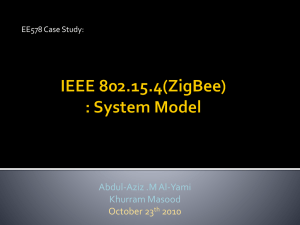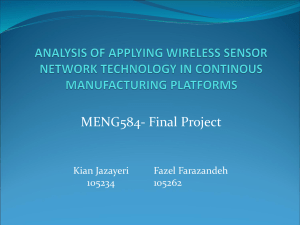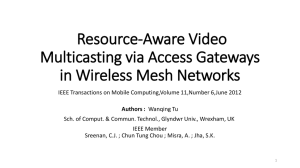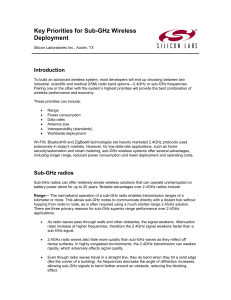RTC03 TCTW SiLabs_originalRCedit_original
advertisement
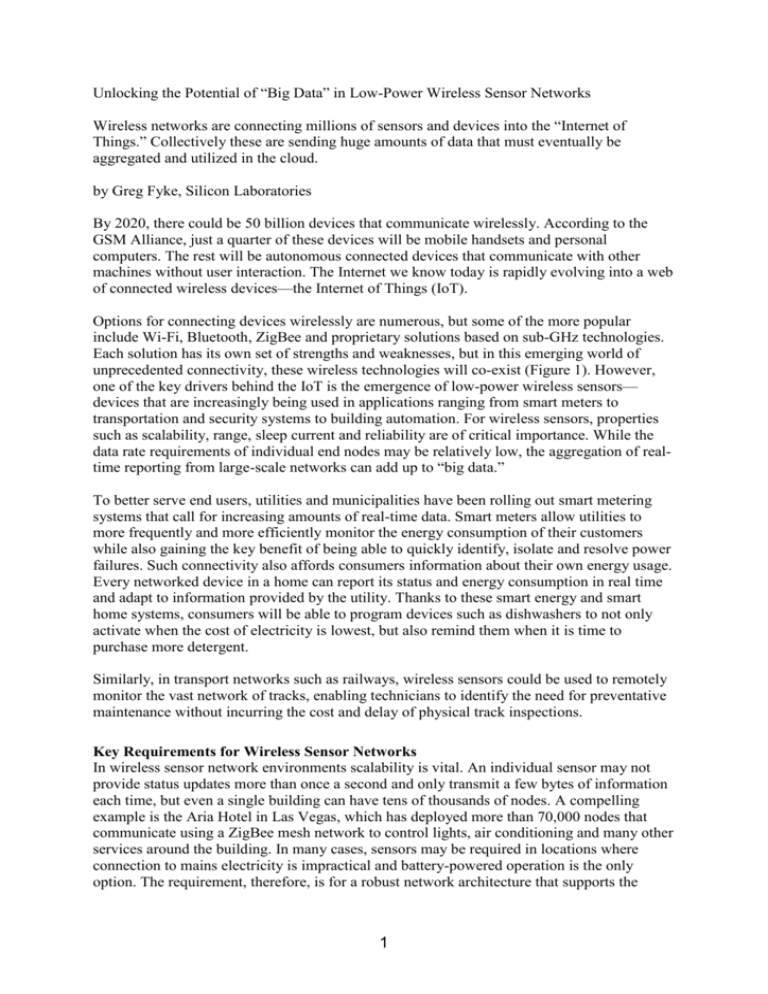
Unlocking the Potential of “Big Data” in Low-Power Wireless Sensor Networks Wireless networks are connecting millions of sensors and devices into the “Internet of Things.” Collectively these are sending huge amounts of data that must eventually be aggregated and utilized in the cloud. by Greg Fyke, Silicon Laboratories By 2020, there could be 50 billion devices that communicate wirelessly. According to the GSM Alliance, just a quarter of these devices will be mobile handsets and personal computers. The rest will be autonomous connected devices that communicate with other machines without user interaction. The Internet we know today is rapidly evolving into a web of connected wireless devices—the Internet of Things (IoT). Options for connecting devices wirelessly are numerous, but some of the more popular include Wi-Fi, Bluetooth, ZigBee and proprietary solutions based on sub-GHz technologies. Each solution has its own set of strengths and weaknesses, but in this emerging world of unprecedented connectivity, these wireless technologies will co-exist (Figure 1). However, one of the key drivers behind the IoT is the emergence of low-power wireless sensors— devices that are increasingly being used in applications ranging from smart meters to transportation and security systems to building automation. For wireless sensors, properties such as scalability, range, sleep current and reliability are of critical importance. While the data rate requirements of individual end nodes may be relatively low, the aggregation of realtime reporting from large-scale networks can add up to “big data.” To better serve end users, utilities and municipalities have been rolling out smart metering systems that call for increasing amounts of real-time data. Smart meters allow utilities to more frequently and more efficiently monitor the energy consumption of their customers while also gaining the key benefit of being able to quickly identify, isolate and resolve power failures. Such connectivity also affords consumers information about their own energy usage. Every networked device in a home can report its status and energy consumption in real time and adapt to information provided by the utility. Thanks to these smart energy and smart home systems, consumers will be able to program devices such as dishwashers to not only activate when the cost of electricity is lowest, but also remind them when it is time to purchase more detergent. Similarly, in transport networks such as railways, wireless sensors could be used to remotely monitor the vast network of tracks, enabling technicians to identify the need for preventative maintenance without incurring the cost and delay of physical track inspections. Key Requirements for Wireless Sensor Networks In wireless sensor network environments scalability is vital. An individual sensor may not provide status updates more than once a second and only transmit a few bytes of information each time, but even a single building can have tens of thousands of nodes. A compelling example is the Aria Hotel in Las Vegas, which has deployed more than 70,000 nodes that communicate using a ZigBee mesh network to control lights, air conditioning and many other services around the building. In many cases, sensors may be required in locations where connection to mains electricity is impractical and battery-powered operation is the only option. The requirement, therefore, is for a robust network architecture that supports the 1 ability to handle large amounts of aggregated data but does not place prohibitive energy demands on the sensor nodes themselves. The combination of reliability, scalability and power efficiency clearly places stringent demands on the communications technology that wireless sensor nodes can adopt. System integrators must consider not only the benefits and weaknesses of the chosen topologies and wireless protocols, but also the underlying physical properties of the radio technology itself. Concrete walls and multi-path fading are unfriendly obstacles to any wireless system, but there are ways to mitigate their impact. To add to that challenge, different countries have their own rules governing the radio spectrum and which frequencies can be used. Fortunately, 2.4 GHz has been made globally available as an unlicensed frequency band, which enables the design of wireless systems that can serve in all major markets worldwide. Wi-Fi, for example, is a ubiquitous communications technology that is based on the 2.4 GHz band. Wi-Fi excels in quickly transporting large amounts of data between two points, but it requires a lot of current to do so and is practically limited to no more than 15 to 30 clients per access point in a star configuration. Bluetooth is another 2.4 GHz technology that has been optimized for portable devices, but is one that was developed primarily as a point-to-point cable-replacement solution and cannot scale to more than a few nodes. ZigBee shares the same radio spectrum as Bluetooth and Wi-Fi but was designed from the outset to address the unique needs of low-power wireless sensor nodes. Table 1 summarizes the key features and capabilities of popular wireless networking technologies. ZigBee: The Optimal Solution for Wireless Mesh Networking ZigBee is an open, global standards-based wireless mesh technology. Unlike conventional networking architectures such as star and point-to-point, mesh networks are capable of providing robust coverage for every location within a building at the lowest cost per node. See Figure 2 for a comparison of network topology alternatives. ZigBee uses a routing protocol that is dynamic and automatic, based on a technique known as Ad Hoc On-demand Distance Vector (AODV) routing. With AODV, when a node needs a connection, it broadcasts a message asking for routes. Nodes with a known route to the destination relay their proposed directions back to the requesting node, which then picks the one with the lowest number of reliable hops. It stores that information in a local routing table for when it is needed, and if a route fails, the node can simply advertise for a replacement route. If the shortest distance between a source and destination is obstructed by walls or multi-path interference, ZigBee can adapt to find a longer but available route. Wireless sensor networks based on Silicon Labs’ EM35x Ember ZigBee SoCs and EmberZNet PRO protocol stack, for example, provide self-configuring and self-healing mesh connectivity that can be extended to interconnect hundreds or potentially thousands of devices on a single network. Rapid development of “ZigBee Certified Products” is aided with the use of Ember AppBuilder, a development tool that goes beyond the stack and focuses on implementation of ZigBee Application Profiles. Using a graphical interface, developers can quickly select the properties needed for their applications, and AppBuilder can then automatically generate the necessary code. Effective debug tools are needed to take best advantage of the flexibility provided by ZigBee networks. The complexity of a mesh network makes it harder to use conventional network analysis tools such as packet sniffers. Due to the fact that packets may traverse multiple hops 2 to reach a destination, many of the intermediate transmissions will be out of the reach of the analyzer, and visibility into the end-to-end path will be lost. A unique solution to this problem is available through Silicon Labs’ Desktop Network Analyzer, a tool that provides developers with a complete view of every packet sent and received in the network in an easyto-use graphical interface. Built-in protocol analysis and traffic visualization engines allow developers to correlate events occurring on their devices with network communication events. There are situations where a mesh network is impractical because the node density is too low to provide effective failover support. For example, the topology of a road or rail network demands the ability to locate nodes with wide spacing along a narrow path. Similarly, the external facilities on a campus may be too sparse to justify the use of a mesh network. In these environments, a star topology is more appropriate coupled with the ability to reliably communicate across greater distances. Sub-GHz: Ideal for Long-Range and Low-Power Communication Wireless propagation is inversely proportional to frequency, and in the battle for low-power, long-range communication or simply the ability to radiate through walls, sub-GHz radios shine. For many applications, 433 MHz can be a viable global alternative to 2.4 GHz (although it is not permitted for wireless applications in Japan). Designs based on 868 MHz and 915 MHz can serve the U.S. and European markets with a single product respectively. A broad range of unlicensed and licensed bands are available to system integrators, enabling a careful balance between optimizing performance for a given region and designing a system with broad geographical utility. In part as a result of this diversity, sub-GHz bands have less spectral pollution when compared to 2.4 GHz. Fewer interferers improve overall network performance by minimizing the number of retries required to complete a transaction. Third-party and standards-based networking stacks are now available for sub-GHz radios, but many vendors still opt for a proprietary solution to optimize the solution to their specific needs. A challenge with many radio protocols is that they demand the interface to be constantly active to “listen” for traffic on the network. Although the transmission of data consumes more instantaneous power than is needed to receive data, the long-term average power consumption is usually much lower because transmissions are brief and separated by long intervals. With many wireless protocols, the receiver does not know when a message intended for it will turn up. It has to keep listening to make sure that it does not lose any data and therefore cannot power down entirely to save energy when it has nothing to do. This scenario can dramatically limit the battery autonomy of the node, demanding that batteries be replaced or recharged regularly. Sub-GHz transceivers, such as Silicon Labs’ Si446x EZRadioPRO IC, support frequencies from 119 to 1050 MHz and a link budget of up to 146 dB, yet offer the ability to consume only 50 nA while asleep. To combat the effects of multipath fading, EZRadioPRO devices are designed to support two antennas and incorporate an antenna diversity algorithm. By employing a combination of frequency hopping and time synchronization techniques, system integrators can realize sub-GHz networks that span many kilometers between coordinators and end-points, with end-points that are capable of operating from a single battery for more than ten years. Such capabilities and flexibility afford system integrators the ability to reliably cover a given region with fewer coordinators while being able to place end points where mains power may not be available. 3 Wireless Coexistence and the Cloud What is clear is that in the world of wireless networking, there is not a “one-size-fits-all” solution. In large-scale, low-power networks, there is no requirement to select just one form of wireless network. Sub-GHz and ZigBee wireless networks can happily coexist as they operate on radically different parts of the radio spectrum and will be selected for their unique attributes. On a campus, for example, 2.4 GHz ZigBee would be best suited for in-building automation systems while sub-GHz would be reserved for outdoor lighting and access control. The ability to reliably and efficiently gather this data is of course paramount, but to truly unlock the potential of all of this real-time information and gain access to analytic, visualization and mobile services, one needs a path to the cloud. Such large-scale networks typically employ backhaul systems that transform the traffic collected from each subnet into the medium that now brokers much of the world’s information—the Internet Protocol (IP). At each collector, additional processing can manipulate the data received into a form suitable for transmission using standard IP frames. Most often, the headers of the networking protocol used in the sensor network will be stripped off and the packet analyzed. The backhaul system can then assemble an IP packet that contains the original data together with source and destination information but without the overhead necessary to maintain the sensor network. These IP packets can then be routed in the same way as any other Internet-bound data, affording service providers the ability to analyze and visualize this new wealth of information using cloud-based services and giving consumers the ability to manage and interact with their data from a tablet, laptop or mobile phone. These are exciting times. Advances in wireless technology and low-power operation have brought to life opportunities to measure, monitor and control our environment in previously unimaginable ways. The use of wireless technology in fields as diverse as waste management and forest fire detection may still be in its infancy, but applications such as smart metering, security and building automation are already enabling businesses and consumers to reap new benefits in efficiency and convenience. Thanks to their respective strengths, the ZigBee protocol and sub-GHz RF systems provide optimal solutions for realizing highly scalable and reliable low-power wireless sensor networks. Growth is accelerating, but we are just seeing the beginning of the Internet of Things. Silicon Laboratories, Austin, TX. (512) 416-8500. [www.silabs.com]. 4




